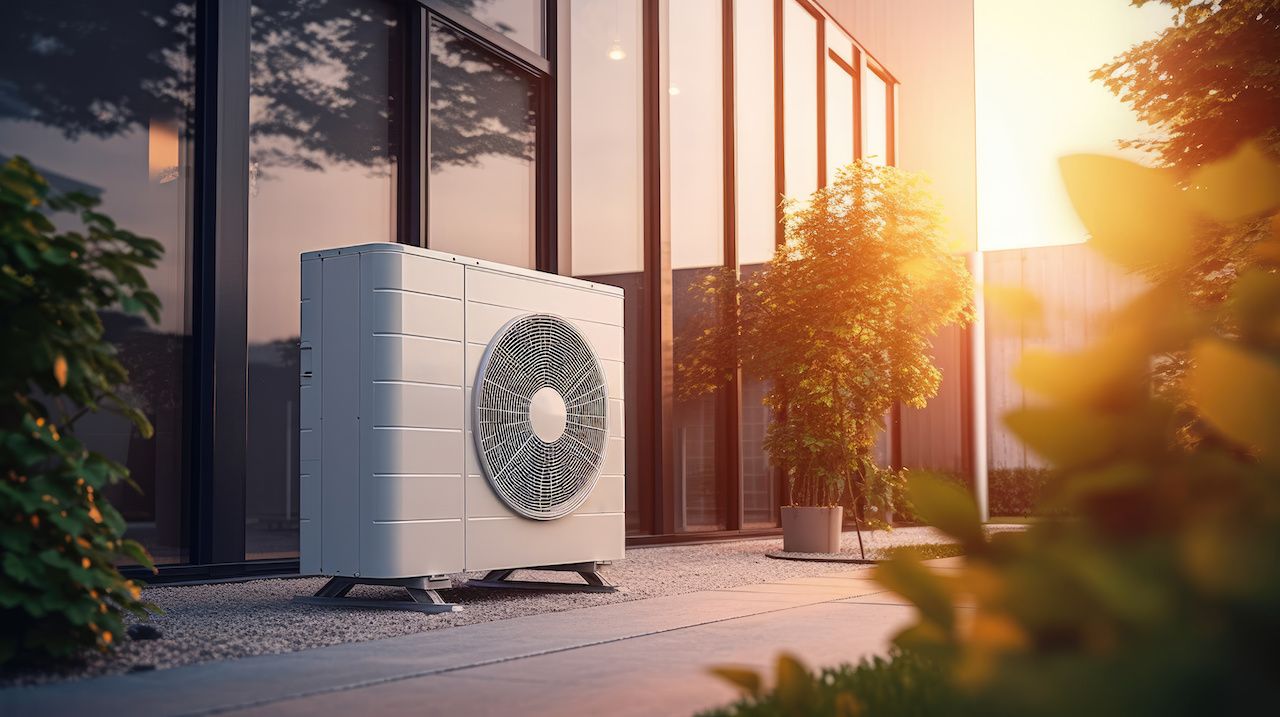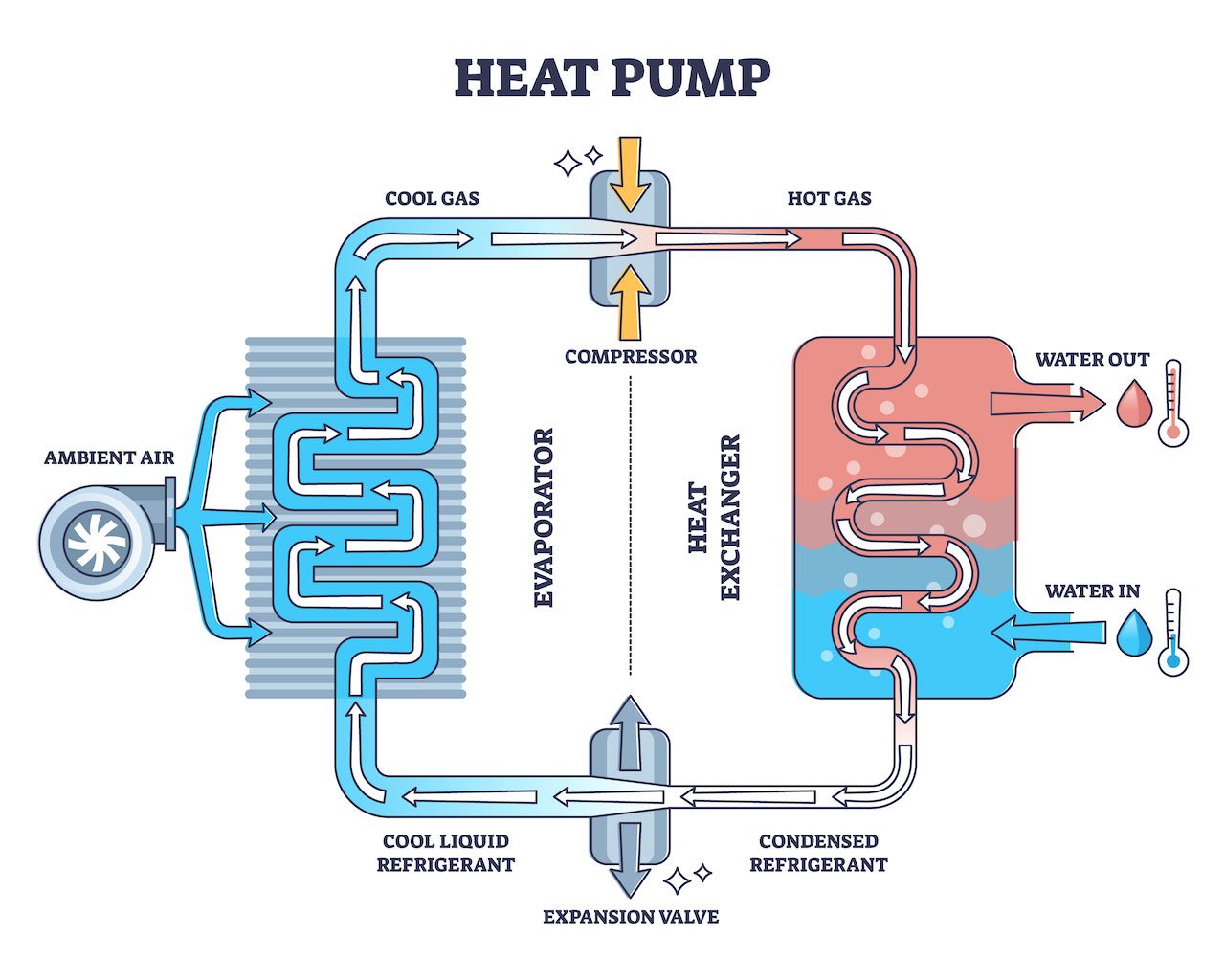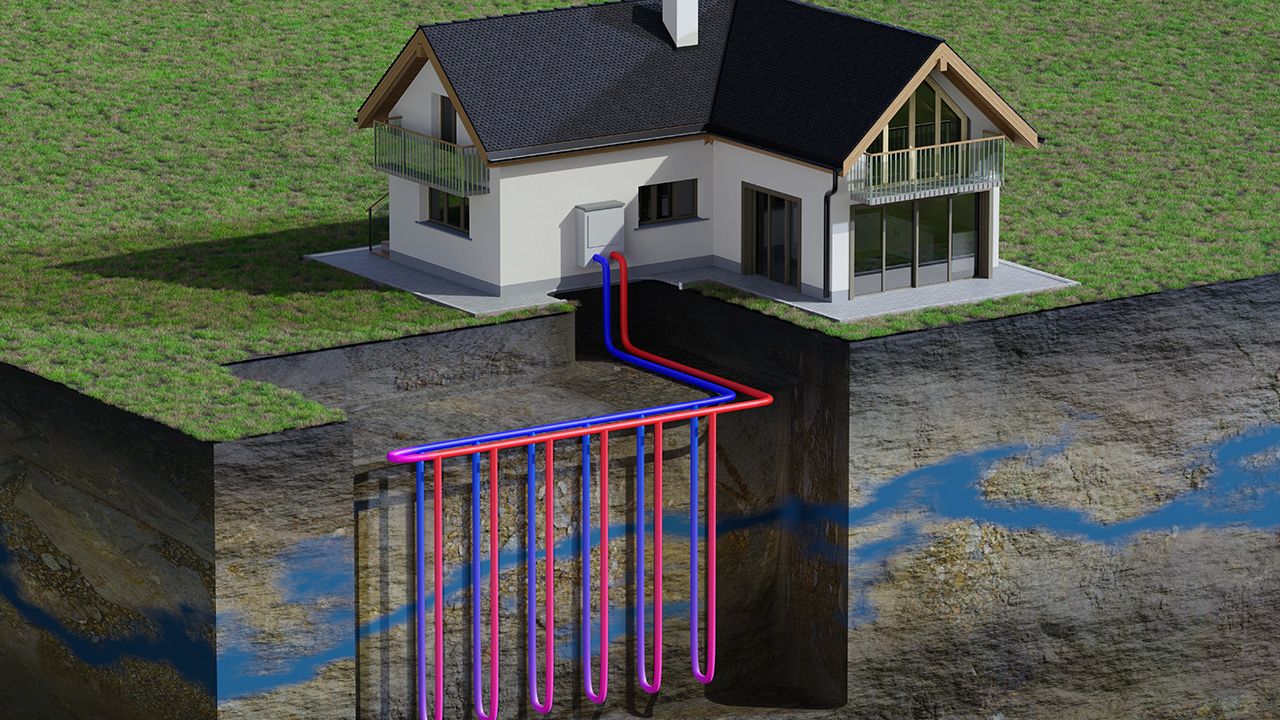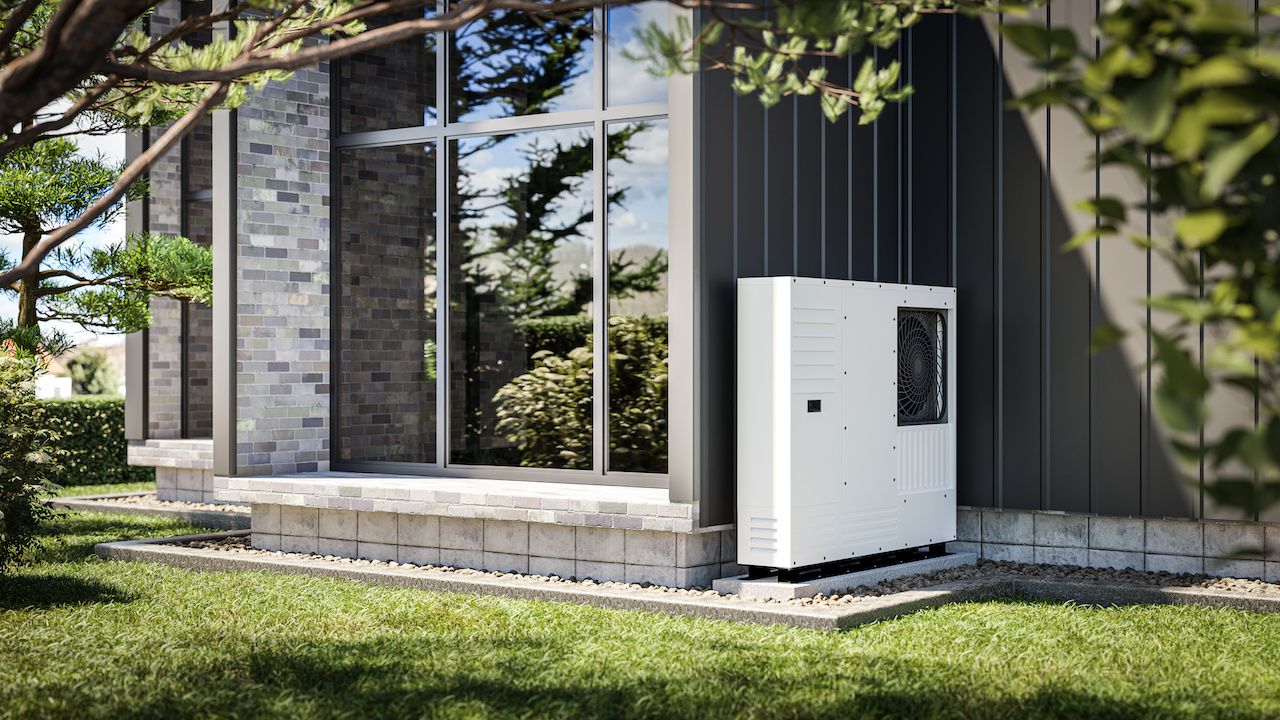Air Source Heat Pumps & More: Energy Efficient Heating and Cooling Solutions
By HeyHome • October 20, 2023

Heat pumps, often deemed as the marvels of modern heating and cooling solutions, have steadily woven their way into the tapestry of our daily lives. As global temperatures see-saw, our quest for comfort inside our homes has sent many homeowners on a hunt for the most efficient way to heat and cool their living spaces. Enter the heat pump.
Why are heat pumps drawing such attention? Firstly, heat pumps aren't new. Their technology has been around for years. However, recent advancements in heat pump technology coupled with a rising awareness towards sustainable living have placed them in the spotlight. Their ability to transfer heat, rather than creating it, places them miles ahead in terms of energy efficiency.
At their core, heat pumps function like a refrigerator. They extract heat from the air outside, even in colder weather, and bring it inside your home. Conversely, during hotter months, the same system can remove heat from the indoor air, ensuring your living space remains cool. In essence, a single heat pump system can offer both heating and cooling, which, when compared to traditional HVAC systems, is a game-changer.
Whether you've heard of air source heat pumps, geothermal heat pumps, or the intriguing ductless mini split systems, each type has its own merits, fitting varied needs. Over the next sections, we'll delve deep into the innovative world of heat pumps, their significance, and their undeniable role in contemporary heating and cooling systems.
For homeowners, the journey towards energy efficiency, cost savings, and optimal home comfort starts with understanding. And that's exactly what we aim to provide in the subsequent chapters.
Join our newsletter
Stay on top of the latest in landscaping and lawn care with one valuable tip right in your inbox every Saturday morning.
Chapter 1: What is a Heat Pump and How Does It Work?
In the realm of heating and cooling, the term 'heat pump' is no stranger. But despite its prevalent use, especially in modern households, the intricacies of its operation remain shrouded in mystery for many. So, let's demystify!
Breaking Down the Concept: Understanding the "Heat Pump"
A heat pump is an energy-efficient device designed to move heat from one location to another. Unlike furnaces that burn fossil fuels or rely on electric resistance to create heat, a heat pump transfers heat. This pivotal difference makes them a favorite when considering energy consumption and efficiency.
In simpler terms, think of a heat pump as a transporter. It doesn’t produce the heat; it merely relocates it. This capacity to shift rather than produce heat is what allows the heat pump to function in both heating and cooling modes.
The Science Behind Transferring Heat Energy
Underpinning every heat pump's operation is the second law of thermodynamics: heat flows from an object at a higher temperature to one at a lower temperature. Utilizing this principle, heat pumps are engineered to force the movement of heat energy against its natural direction (from cold to hot).
At the heart of this process lies the heat exchanger, a component designed to facilitate the efficient exchange of heat between a refrigerant and the environment. The refrigerant, a substance with a very low boiling point, plays a pivotal role in absorbing and releasing heat during the heat pump's operation.

Heating Mode vs. Cooling Mode: How Heat Pumps Work in Different Seasons
- Heating Mode: In this mode, the heat pump extracts heat from the air (or ground, in the case of ground source heat pumps) outside and transfers it inside to warm the indoor air. Even when it feels cold outside, there's enough heat present for the heat pump to work efficiently. The refrigerant absorbs this external heat, and after undergoing compression, releases it inside to warm the home.
- Cooling Mode: When the seasons switch, and the home needs cooling, the heat pump reverses its operation. It extracts the heat from the inside your home and releases it outside. This is achieved by simply reversing the flow of the refrigerant. The indoor unit acts as the evaporator, absorbing heat from the indoor air, while the outdoor unit dissipates this heat, cooling the inside of the home.
In both modes, the beauty of the heat pump is its duality. With the flip of a switch, it can either bring warmth during chilly winter nights or provide respite in the sweltering summer afternoons.
The versatility, efficiency, and simplicity of the heat pump's operation underscore its prominence in the world of heating and cooling systems. As we journey deeper, we'll uncover more about the different types of heat pumps and their specific advantages.

Chapter 2: Different Types of Heat Pumps for Every Home
With the rising significance of energy-efficient heating and cooling systems, heat pumps have become a cornerstone in modern HVAC solutions. However, saying 'heat pump' is a bit like saying 'vehicle'. Just as there are trucks, cars, and motorcycles under the umbrella term 'vehicle', there are various types of heat pumps tailored for distinct needs and environments.
Introduction to Types of Heat Pumps: Not All Are Created Equal
Every home is unique. From its architectural design to its geographical location, numerous factors determine which type of heat pump will serve its needs best. Recognizing the diversity of homes and their respective requirements, the industry has cultivated several heat pump systems, each boasting specialized features and benefits.
Air Source Heat Pumps: The Most Popular Choice
Air source heat pumps are, by far, the most commonly used type among homeowners. They are designed to extract heat from the outside air and then transfer it inside. Conversely, during the summers, they pull heat from the inside your home and release it outdoors.
Key Features:
- Energy Efficient: They can reduce electricity use by about 50% when compared to furnaces and baseboard heaters.
- Heating and Cooling: Offering a dual function, they can warm up or cool down your home depending on the season.
- Seasonal Energy Efficiency Ratio (SEER) and Heating Seasonal Performance Factor (HSPF): These are metrics to gauge their efficiency, with higher numbers indicating greater efficiency.
Ground Source Heat Pumps and Geothermal Technology
Ground source heat pumps, often referred to as geothermal heat pumps, utilize the stable temperature of the earth or underground water sources to provide heating and cooling. Unlike air source variants that draw heat from the air, these leverage the consistent temperatures found just a few feet below the ground.
Key Features:
- Consistency: They offer more consistent temperatures as the ground temperature remains relatively stable.
- High Efficiency: Often more efficient than air source counterparts because of their reliance on the steady ground temperature.
- Longevity: These systems tend to have a longer lifespan, given that their main components are sheltered underground, protected from weather extremes.

Ductless Mini Split Systems: A Unique and Versatile Solution
Ductless mini split heat pumps, or simply mini splits, are a type of air source heat pump that doesn't require ducts. They are ideal for homes without existing ductwork or for room additions where extending ductwork is impractical.
Key Features:
- Versatility: Can be installed in various locations around the home, including wall-mounted units or ceiling recessed designs.
- Zonal Heating and Cooling: Allows for temperature control in individual rooms or zones.
- Efficiency: Absence of ducts reduces energy losses, making them more energy efficient.
Heater Pump: A Misunderstood Term Clarified
You might occasionally hear the term 'heater pump', but it's essential to clarify that there isn't a distinct device called a 'heater pump'. It's a misnomer or misunderstanding of the term 'heat pump'. Whether in heating mode or cooling mode, a heat pump is always moving heat, not just producing it. Remember, a heat pump transfers heat; it doesn't merely generate it.
Chapter 3: Heating and Cooling with Efficiency: The Benefits of Heat Pumps
As our society gravitates more towards sustainability and energy-efficient solutions, heat pumps have emerged as frontrunners in the race to efficient home climate control. Offering a green alternative to conventional heating and cooling systems, heat pumps promise not only financial savings but also a significant reduction in carbon footprints.
The Environmental and Energy-Saving Advantage
Heat pumps stand apart for their ability to offer energy-efficient heating and cooling. Unlike systems that rely on combustion and generate heat, heat pumps simply transfer heat. This means they use significantly less energy, reducing the reliance on fossil fuels and thereby diminishing greenhouse gas emissions. By adopting this heat pump technology, homeowners can take an active role in combating climate change while also saving on energy bills.
How Heat Pumps Contribute to Energy-Efficient Heating and Cooling
- Heat Transfer Over Heat Creation: Traditional systems, like gas furnaces or electric resistance heaters, create heat by burning fuel or using electricity. Heat pumps, on the other hand, work by transferring heat from one place to another. This is far more energy efficient, especially when you consider heat from the air or heat from the ground as sources.
- Multi-functional Design: With the ability to both heat and cool, a heat pump eliminates the need for separate systems. This dual-function means homeowners don't need an additional air conditioner or heating system.
- Optimized Energy Use: Advanced heat pump systems adjust their output based on the need, ensuring they use just the right amount of energy. This adaptive behavior ensures optimal energy-efficient heating and cooling throughout the year.
High Efficiency vs. Standard Systems: What's the Difference?
High efficiency systems are optimized to use as little energy as possible while delivering top-notch performance. On the other hand, standard systems might not utilize the latest technologies or adaptive mechanisms to modulate energy use. A high efficiency heat pump will have a higher Seasonal Energy Efficiency Ratio (SEER) and Heating Seasonal Performance Factor (HSPF), both crucial metrics in determining a system's efficiency.

The Seasonal Energy Efficiency Ratio (SEER) Explained
The SEER rating of a heat pump is a measure of its cooling efficiency. It is calculated by dividing the cooling output during a typical cooling season by the total electric energy input. The higher the SEER, the greater the heat pump's efficiency. When comparing heat pumps, it's always recommended to choose one with a higher SEER as it indicates better performance and more savings on energy bills.
Chapter 4: Installing a Heat Pump: Factors to Consider
With the undeniable benefits that heat pumps bring to the table, many homeowners are considering making the switch. However, like any significant home improvement, installing a heat pump requires careful thought and consideration. From understanding the unique requirements of your space to assessing long-term cost benefits, there's much to deliberate.
The Prerequisites: Inside and Outside Your Home
Before diving into the installation, it's essential to ensure that both the interior and exterior of your home are ready to accommodate a heat pump system.
- Inside Your Home:
- Space: Ensure you have the required space for an indoor unit, preferably away from direct sunlight and heat sources.
- Electrical Setup: Some heat pumps might require electrical upgrades. Make sure to check compatibility with your home's current electrical system.
- Duct System (if applicable): For homes with existing ductwork, it needs to be in good condition. If considering a ductless mini split heat pump, this isn’t a concern.
- Outside Your Home:
- Location: The external unit needs to be in a location where it can easily draw outside air. Keep it away from areas with debris or high foot traffic.
- Foundation: A firm, level surface is essential for the outdoor unit. This prevents vibrations and ensures efficient functioning.
- Clearance: Ensure there's adequate space around the unit for unrestricted airflow and easy maintenance.
Join our newsletter
Stay ahead of the curve in all things outdoor.
Get the inside scoop on the latest landscaping, lawn care, and fencing trends with 1 actionable tip every Saturday morning.
Heat Pump Installation: Steps, Challenges, and Professional Insights
Installing a new heat pump isn't a DIY project. It's intricate and requires professional expertise. Here’s a basic breakdown:
- Site Assessment: Before anything else, a professional will assess your home to recommend the right type of heat pump and the best installation spots.
- Choosing the Right System: Based on the assessment, you’ll be advised on the ideal heat pump, whether it’s an air source heat pump, ground source heat pump, or ductless mini split.
- Installation:
- Indoor Unit: Placed inside, typically on a wall or ceiling.
- Outdoor Unit: Installed outside and connected to the indoor unit through cables and pipes.
- Ductwork (if necessary): For ducted systems, this step involves integrating the heat pump with the home's existing duct system or installing new ductwork.
- Challenges:
- Unforeseen Site Issues: Sometimes, unexpected challenges, like inadequate electrical systems or structural hindrances, can arise.
- Integration with Existing HVAC Systems: Integrating a heat pump with existing HVAC systems can be complex, especially if they're older models.
- Professional Insights:
- Always choose a reputable installer who is familiar with local regulations and the specific heat pump technology you're opting for.
- Post-installation, regular maintenance is crucial to ensure longevity and efficiency.
Cost-Benefit Analysis: Heat Pump Cost vs. Long-Term Savings
While the initial heat pump cost can be higher than traditional systems, the long-term benefits often outweigh these initial expenses.
- Energy Savings: Heat pumps are more energy efficient, so while there’s an upfront cost, monthly energy bills often decrease, leading to significant savings over time.
- Durability: Heat pumps have longer lifespans than traditional heating systems and air conditioners, which means fewer replacements and repairs.
- Incentives: Many regions offer tax credits, rebates, or incentives for installing energy-efficient systems, further offsetting the heat pump installation cost.
- Environmentally Friendly: By reducing your reliance on fossil fuels, you're not only saving money but also contributing to a greener planet.
Chapter 5: Heat Pump Systems: Potential Issues and Maintenance Tips
Even the most advanced heat pump systems aren't immune to potential issues. Like all mechanical devices, wear and tear is natural. By understanding common challenges and maintaining your system, you can ensure optimal heating and cooling performance and longevity.
Common Challenges: From Cooling Systems to Gas Furnace Integration
Understanding what can go wrong can better equip homeowners to address issues early on:
- Cooling System Inefficiency: Occasionally, a heat pump may struggle to cool effectively. This could be due to issues such as a low refrigerant, faulty thermostat, or blocked coils.
- Heating Mode Challenges: When in heating mode, the heat pump might not provide adequate warmth. This can result from outdoor units being blocked by ice or debris, a malfunctioning reversing valve, or a gas furnace integration issue.
- Strange Noises: Unusual sounds often indicate mechanical problems, be it from the indoor unit, outdoor unit, or even the duct system.
- Gas Furnace Integration: If you have a dual system that includes a heat pump and a gas furnace, you might face integration problems. This is especially true if one system is much older than the other.
Tips to Ensure High Efficiency and Optimal Heating and Cooling Performance
Regular maintenance and proactive care can significantly reduce the chances of encountering issues:
- Regular Professional Check-ups: Schedule routine check-ups with an expert to ensure all parts of your heat pump system are functioning correctly.
- Clean or Replace Filters: Dirty filters restrict airflow, affecting the efficiency. Ensure you clean or replace them regularly for optimal heating and cooling performance.
- Inspect Coils and Fins: Make sure the coils are clean, and the fins are straight to ensure effective heat exchange.
- Clear Surroundings: Keep the area around outdoor units clear from debris, plants, and snow to ensure unobstructed airflow.
- Thermostat Settings: Regularly check your thermostat settings to ensure they're accurate. Misconfigurations can lead to heating and cooling inefficiencies.
- Avoid Constantly Changing Modes: Constantly switching between heating mode and cooling mode can strain the system. Avoid doing this unless necessary.
- Check for Leaks: Look for signs of refrigerant leaks. If detected, call a professional. It's not just about efficiency—refrigerant leaks can be hazardous.
When to Consider an Upgrade or a New Heat Pump System
Chapter 6: Advanced Topics in Heat Pump Technology
The world of heat pump technology is continuously evolving. As we better understand the intricacies of heating and cooling systems, advancements in design, efficiency, and integration with other hvac systems emerge. Let's delve into some of the advanced topics in this realm.
From HVAC Systems to Innovative Heat Pump Technology Advancements
Modern hvac systems are increasingly integrating heat pumps to ensure energy efficient heating. As heat pump technology advances, we are witnessing:
- Integration with AI and Smart Home Systems: Modern heat pumps can now integrate seamlessly with smart home systems, allowing homeowners to optimize their heating and cooling based on predictive algorithms.
- Variable-Speed Compressors: Traditional compressors operated in a binary manner - on or off. Variable-speed compressors can adjust their speed based on the need, ensuring more consistent temperatures and greater efficiency.
- Enhanced Coil Designs: Advanced heat pumps are coming equipped with enhanced coils that improve the heat transfer rate, providing faster heating or cooling.
The Role of Heat Exchangers and Electric Resistance in the System
At the heart of every heat pump system is the heat exchanger. This component plays a pivotal role in determining the efficiency and performance of the system.
- Heat Exchanger: A heat exchanger is responsible for transferring heat energy from one medium to another. In heat pumps, it transfers heat from the air or heat from the ground to provide heating or cooling inside your home.
- Electric Resistance: While heat pumps are efficient, there are times, especially in extreme cold, when additional heating might be required. This is where electric resistance comes into play. It acts as a supplementary heating system to the main heat pump, ensuring your home remains cozy even in the harshest of winters.
Exploring Gas Fired Heat Pumps and Their Potential
One of the intriguing advancements in heat pump technology is the introduction of gas fired heat pumps. Unlike traditional systems that rely on electricity, these systems utilize natural gas:
- Efficiency in Cold Climates: Gas fired heat pumps can be more efficient than traditional electric systems, especially in colder climates where electric resistance heating can be energy-intensive.
- Reduction in Fossil Fuel Consumption: While they use natural gas, they are designed to utilize it more efficiently than traditional gas furnaces, thereby reducing fossil fuel consumption.
- Integration with Existing Gas Lines: For homes already equipped with gas lines, installing a new gas fired heat pump can be straightforward, utilizing the existing infrastructure.
- Dual Systems: Some gas fired heat pumps are designed to work in conjunction with existing heating systems, offering both electric and gas-based heating based on the need.
Conclusion: Embracing the Future of Heating and Cooling with Heat Pumps
As we reflect on our journey through the fascinating world of heat pumps, it's evident that their evolution is a testament to human ingenuity in the quest for sustainable home comfort. From their foundational science of transferring heat energy to the intricate details of their diverse types, heat pumps have solidified their position as a cornerstone in modern heating and cooling solutions.
The potential of heat pumps is not merely confined to their current capabilities. As we look towards the future, we envision homes that are not only comfortable but also echo the ethos of sustainability. Energy efficient homes will become the norm, not the exception. Heat pumps, with their inherent efficiency and adaptability, will play a pivotal role in this transition. Whether it's the ubiquity of air source heat pumps or the increasing interest in gas fired heat pumps and geothermal technology, the future looks promising.
For homeowners, this journey through heat pump technology is not just a theoretical exploration. It's an invitation—a call to action. As stewards of our planet and caretakers of our homes, making informed decisions about heating and cooling systems is both a personal and global responsibility. Whether you're contemplating installing a new heat pump, upgrading an existing system, or simply curious about the heat energy mechanics, the power to create change rests in your hands.
To close, it's important to remember that while technology will continue to evolve, the principles of sustainability and efficiency are timeless. By embracing heat pumps and their myriad benefits, we're not just investing in our immediate comfort. We're taking a step towards a future where our homes, and by extension our planet, thrive in harmony.
Join our newsletter
Stay ahead of the curve in all things outdoor.
Get the inside scoop on the latest landscaping, lawn care, and fencing trends with 1 actionable tip every Saturday morning.